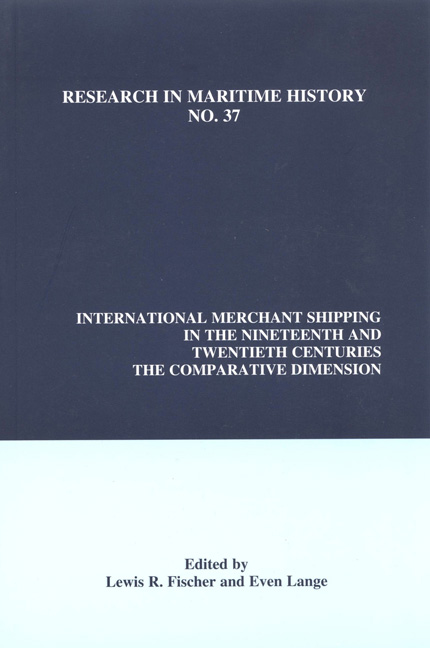Book contents
- Frontmatter
- Contents
- Contributors' Notes
- Contributors
- Introduction
- “Growth, Diversification and Globalization: Main Trends in International Shipping since 1850”
- “Norwegian Shipping in the Twentieth Century”
- “The Greek Shipping Sector, c. 1850-2000”
- “A Guide to the Emergence of Japan's Modern Shipping Industries”
- “British Shipping from the Late Nineteenth Century to the Present”
- “North of England Shipowners and Their Business Connections in the Nineteenth Century”
- “Network Structures, Processes and Dynamics: Inter-firm Cooperative Frameworks in the Shipping Industry”
“A Guide to the Emergence of Japan's Modern Shipping Industries”
- Frontmatter
- Contents
- Contributors' Notes
- Contributors
- Introduction
- “Growth, Diversification and Globalization: Main Trends in International Shipping since 1850”
- “Norwegian Shipping in the Twentieth Century”
- “The Greek Shipping Sector, c. 1850-2000”
- “A Guide to the Emergence of Japan's Modern Shipping Industries”
- “British Shipping from the Late Nineteenth Century to the Present”
- “North of England Shipowners and Their Business Connections in the Nineteenth Century”
- “Network Structures, Processes and Dynamics: Inter-firm Cooperative Frameworks in the Shipping Industry”
Summary
To a large extent shipping is a service industry which reflects the circumstances under which it operates. This is certainly true in the case of Japan. The country consists of four main and numerous small islands which extend for over 2000 kilometres and thus includes considerable climatic differences. The total landmass is approximately fifty percent greater than the UK, but it is largely mountainous, and only a fifth of the land can be farmed. The limited amount of flat area has had the effect of concentrating the population into a coastal strip which runs from the Kanto Plain, around Tokyo and through to the Kansai Plain, which includes the major cities of Osaka, Kobe and Kyoto. Since much of the food, mainly rice, needed to be moved to these expanding regions from elsewhere in Japan, a major coastal and inter-island trade gradually emerged, undertaken by small vessels which incorporated features of both the galley and the junk and which were well adapted to local conditions. By 1600 some of these wasen were reported to have reached a size of 700 tons and were sailing to Luzon, China and Siam, where small Japanese communities had already been established.
Indeed, some authorities have suggested that had these trends continued, a Japanese conquest of the Philippines might have followed, and parts of Australia could have been settled. In reality, the Tokugawa government (which had recently united the country) decided to end Japan's tentative links with the outside world, and from 1638 an era of seclusion was established which prevented virtually all overseas contacts. The only exception to this rule was that one or two Dutch vessels were permitted to call at Deshima - an island close to Nagasaki - each year, and small numbers of Chinese merchants were allowed on the same site from time to time. These restrictions had a dramatic effect on Japanese ship construction, and this was made explicit by an edict which limited the wasen to a maximum of fifty tons.
For the subsequent two hundred years Japan was effectively isolated, and the nation evolved free from major foreign influences. One consequence of this long period of peace was the growth of population, which by 1870 had risen to over thirty million, with a million living in Edo (later renamed Tokyo).
- Type
- Chapter
- Information
- International Merchant Shipping in the Nineteenth and Twentieth CenturiesThe Comparative Dimension, pp. 105 - 124Publisher: Liverpool University PressPrint publication year: 2008



